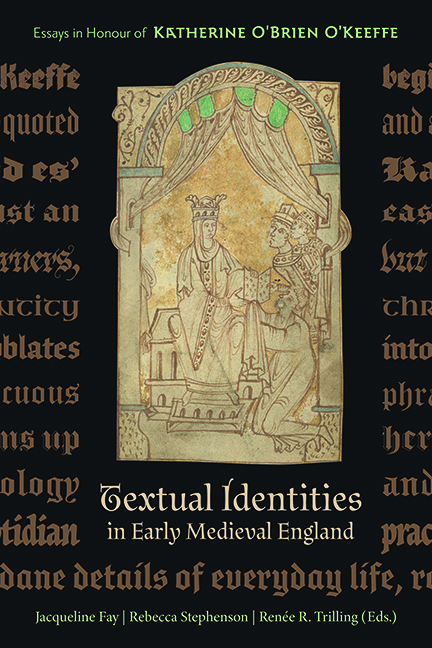Book contents
- Frontmatter
- Contents
- List of Illustrations
- List of Contributors
- Acknowledgments
- List of Abbreviations
- Introduction
- Part One Affect and Embodied Cognition in Medieval Didactic Texts
- Part Two Sovereignty, Power, and English Textual Identities
- Part Three Acts of Public Record in Making and Sustaining Communities
- Overview Of Career
- The Writings of Katherine O’Brien O’Keeffe
- Bibliography
- Index of Manuscripts
- General Index
- Tabula Gratulatoria
- Anglo-Saxon Studies
11 - Holy Women on Display in Ælfric's Lives of Saints
Published online by Cambridge University Press: 26 May 2022
- Frontmatter
- Contents
- List of Illustrations
- List of Contributors
- Acknowledgments
- List of Abbreviations
- Introduction
- Part One Affect and Embodied Cognition in Medieval Didactic Texts
- Part Two Sovereignty, Power, and English Textual Identities
- Part Three Acts of Public Record in Making and Sustaining Communities
- Overview Of Career
- The Writings of Katherine O’Brien O’Keeffe
- Bibliography
- Index of Manuscripts
- General Index
- Tabula Gratulatoria
- Anglo-Saxon Studies
Summary
NEAR THE end of the twentieth century, Katherine O’Brien O’Keeffe explored a shift that occurred near the end of the tenth century in the social meanings of displaying bodies in England. She noted that (at least by the year 1036) a person's internal guilt was signalled by external, bodily signs. O’Brien O’Keeffe explored the interpretations of bodily mutilation and its legal adoption as an evidentiary trial, but her conclusions apply beyond the legal sphere and beyond mutilation specifically. In this chapter, I extrapolate from O’Brien O’Keeffe's analytical framework to examine the display – actual or attempted – of women's bodies in Ælfric's Lives of Saints. Public exposure figures frequently in Ælfric’s Lives of women saints especially, and his treatment of the issue reveals a particular interest in the practice. I demonstrate that the exposure of women's bodies, especially bodies of unmarried holy women, is necessary for expanding the Christian community.
Each of the five unmarried holy women in the Lives of Saints suffers violation or attempted violation. Agnes was to be punished by being stripped naked and dragged to a brothel in an effort both to humiliate her and to objectify her sexually in front of a crowd of onlookers. No such exposure ever occurs, as Agnes's hair miraculously grows to cover her body. After she is brought into the brothel, God sends her a shining tunic to cover her body again, and Agnes is thus doubly protected from anyone seeing her naked. Lucy was also to be dragged publicly to a brothel to ruin her virginity, but her body became miraculously immoveable. In Agatha's tortures, her breast is cut off, but that state lasts a thankfully short time, as her body is miraculously healed and returned to a state of untouched perfection. Evidence of that miracle, however, is initially concealed by a bright light that chases off the guards and keeps them from seeing her healed breast. For these three saints, a display of their bodies is miraculously prevented in order to protect their virginity and sanctity. On the other hand, Eugenia's and Æthelthryth's bodies must be displayed in the course of their hagiographies.
- Type
- Chapter
- Information
- Textual Identities in Early Medieval EnglandEssays in Honour of Katherine O'Brien O'Keeffe, pp. 244 - 258Publisher: Boydell & BrewerPrint publication year: 2022



